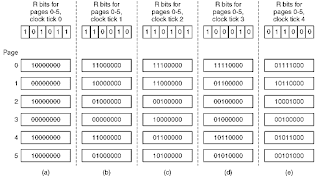The aging algorithm is a descendant of the NFU algorithm, with modifications to make it aware of the time span of use.Instead of just incrementing the counters of pages referenced, putting equal emphasis on page references regardless of the time, the reference counter on a page is first shifted right (divided by 2), before adding the referenced bit to the left of that binary number.Suppose that after the first clock tick the R bits for pages 0 to 5 have the values 1,0, 1, 0, 1, and 1, respectively (page 0 is 1, page 1 is 0, page 2 is 1, etc.). In other words, between tick 0 and tick 1, pages 0, 2, 4, and 5 were referenced, setting their R bits to 1, while the other ones remain 0.
When a page fault occurs, the page whose counter is the lowest is removed. It
is clear that a page that has not been referenced for, say, four clock ticks will have four leading zeros in its counter and thus will have a lower value than a counter that has not been referenced for three clock ticks.
Aging differs from LRU in the sense that aging can only keep track of the references in the latest 16/32 (depending on the bit size of the processor's integers) time intervals. Consequently, two pages may have referenced counters of 00000000, even though one page was referenced 9 intervals ago and the other 1000 intervals ago. Generally speaking, knowing the usage within the past 16 intervals is sufficient for making a good decision as to which page to swap out. Thus, aging can offer near-optimal performance for a moderate price.
Monday, January 18, 2010
Aging Page Replacement Algorithm
Posted by
Sunflower
at
1/18/2010 04:13:00 PM
![]()
Labels: Aging, Algorithms, Operating Systems, Page Replacement, Page replacement Algorithm, pages
|
| Subscribe by Email |
|
Subscribe to:
Post Comments (Atom)
No comments:
Post a Comment